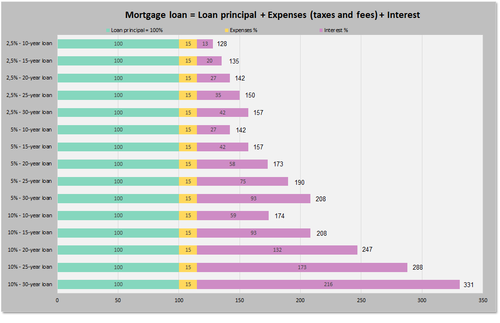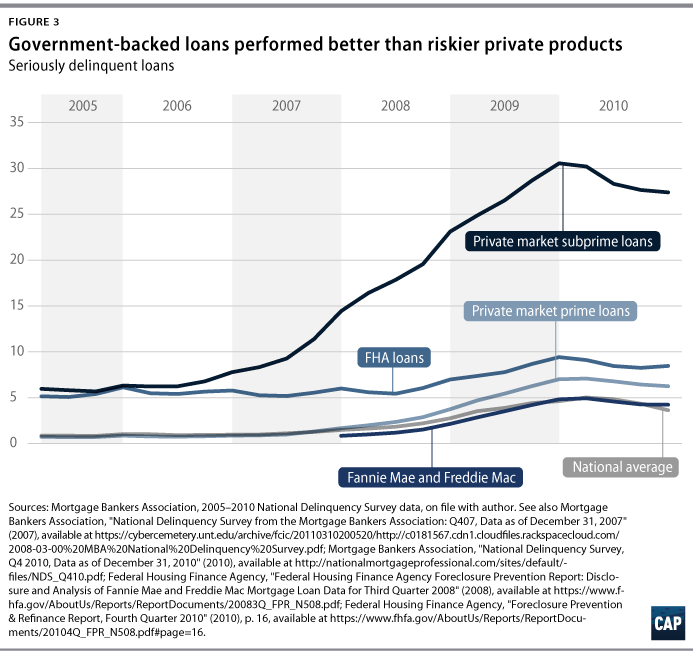For this argument to hold, the boost in the rate of foreclosure would need to precede the decline in house costs. In reality, the opposite occurred, with the national rate of home price appreciation peaking in the 2nd quarter of 2005 and the outright cost level peaking in the 2nd quarter of 2007; the significant boost in new foreclosures was not reached until the second quarter of 2007.
Usually one would expect the supreme investors in mortgagerelated securities to impose market discipline on lending institutions, making sure that losses remained within expectations. Market discipline began to breakdown in 2005 as Fannie Mae and Freddie Mac became the largest single buyers of subprime mortgagebacked securities. At the height of the marketplace, Fannie and Freddie acquired over 40 percent of subprime mortgagebacked securities.
Fannie and Freddie entering this market in strength considerably increased the need Look at this website for subprime securities, and as they would ultimately be able to pass their losses onto the taxpayer, they had little reward to effectively keep track of the quality of underwriting. The past few decades have actually experienced a substantial expansion in the variety of monetary regulators and regulations, contrary to the extensively held belief that our monetary market policies were "rolled back." While numerous regulators might have been shortsighted and overconfident in their own ability to spare our financial markets from collapse, this failing is among guideline, not deregulation.
See This Report on School Lacks To Teach Us How Taxes Bills And Mortgages Work
To discuss the financial crisis, and prevent the next one, we must take a look at the failure of guideline, not at a legendary deregulation.

So, "what triggered the home mortgage crisis" anyway? In case you have not heard, timeshare cancellation reviews we went through one of the worst real estate busts in our lifetimes, if not ever - what is the best rate for mortgages. And though that much is clear, the reason behind it is much less so. There has been a great deal of finger pointing. In reality, there wasn't simply one cause, but rather a mix of forces behind the housing crisis.

Banks weren't keeping the loans they madeInstead they're were selling them to financiers on the secondary marketWho were slicing and dicing them into securitiesThe transfer of risk allowed more risky loans to be madeIn the old days, banks utilized to make mortgages in-house and keep them on their books. Due to the fact that they kept the loans they made, stringent underwriting guidelines were put in place to ensure quality loans were made.
What Percentage Of National Retail Mortgage Production Is Fha Insured Mortgages Can Be Fun For Anyone
And they 'd lose great deals of money. Recently, a new phenomenon came along where banks and home mortgage lenders would stem house loans and rapidly resell them to investors in the form of mortgage-backed securities (MBS) on the secondary market (Wall Street). This technique, called the "stem to disperse model," enabled banks and loan providers to pass the risk onto investors, and therefore loosen standards.
Banks and loan providers also count on circulation channels outside their own roofing, via home mortgage brokers and correspondents. They incentivized bulk originating, pressing those who worked for them to close as many loans as possible, while forgeting quality standards that ensured loans would really be repaid. Due to the fact that the loans were being sliced and diced into securities and sold wholesale, it didn't matter if you had a few bad ones here and there, a minimum of not initiallyThis pair wasn't complimentary from blame eitherThey were quasi-public companiesThat were attempting to keep personal investors happyBy easing underwriting guidelines to stay relevantOf course, banks and lenders modeled their loan programs on what Fannie and Freddie were buying, so one might likewise argue that these two "government-sponsored enterprises" also did their reasonable share of damage.
And it has been alleged that the pair eased guidelines to remain pertinent in the mortgage market, mainly due to the fact that they were publicly traded business progressively losing market share to private-label securitizers. At the exact same time, they also had lofty cost effective real estate goals, and were instructed to offer financing to a growing number of low- and moderate-income borrowers with time, which plainly came with more danger.
7 Simple Techniques For Hedge https://daltoneifa.bloggersdelight.dk/2021/04/08/what-does-what-is-the-current-interest-rate-for-home-mortgages-mean/ Funds Who Buy Residential Mortgages
As an outcome, bad loans looked like higher-quality loans since they conformed to Fannie and Freddie. what is the interest rate today on mortgages. And this is why quasi-public business are bad news folks. The underwriting, if you could even call it thatWas atrocious at the time leading up to the home loan crisisBasically anyone who looked for a home mortgage might get approved back thenSo once the well ran dry many of these homeowners stopping payingThat brings us to bad underwriting.
They were frequently informed to make loans work, even if they seemed a bit dodgy at finest. Again, the reward to approve the loan was much, much higher than decreasing it. And if it wasn't approved at one shop, another would be pleased to come along and take the business.
So you could get away with it. The appraisals at the time were also extremely suspectEmphasis on "high" rather than lowSince the worths were frequently grossly inflated to make the substandard loan workThis even more propped up house prices, enabling much more bad loans to be createdGoing hand-in-hand with bad underwriting was malfunctioning appraising, typically by deceitful house appraisers who had the same reward as lenders and begetters to make certain the loans closed.
9 Easy Facts About Why Do Holders Of Mortgages Make Customers Pay Tax And Insurance Explained
If one appraiser didn't like the worth, you could constantly get a consultation elsewhere or have them reevaluate. Home prices were on the up and up, so a stretch in worth could be hidden after a few months of gratitude anyway. And don't forget, appraisers who found the best value every time were guaranteed of another offer, while those who couldn't, or would not make it take place, were passed up on that next one.
Back when, it was common to put down 20 percent when you acquired a house. In the last couple of years, it was increasingly typical to put down 5 percent and even nothing. In truth, no down home loan funding was all the rage due to the fact that banks and customers could depend on house cost gratitude to keep the idea of a home as a financial investment practical.
Those who bought with zero down just selected to stroll away, as they really had no skin in the game, nothing to keep them there. Sure, they'll get a huge ding on their credit report, however it beats losing an entire lot of money. Alternatively, those with equity would definitely set up more of a fight to keep their home.
Who Issues Ptd's And Ptf's Mortgages for Beginners
As house rates marched higher and greater, lenders and house contractors had to create more imaginative funding choices to generate buyers. Since house costs weren't going to boil down, they had to make things more budget friendly. One technique was decreasing month-to-month home loan payments, either with interest-only payments or negative amortization programs where customers actually paid less than the note rate on the loan.
This obviously resulted in scores of underwater debtors who now owe more on their home mortgages than their existing residential or commercial property worths - what is the concept of nvp and how does it apply to mortgages and loans. As such, there is little to any incentive to remain in the home, so debtors are significantly defaulting on their loans or walking away. Some by option, and others because they could never ever manage the true regards to the loan, just the initial teaser rates that were provided to get them in the door.